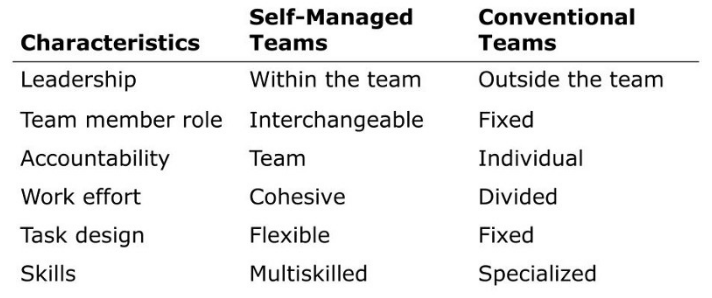Management is a prominent subject nowadays. Wherever there are people, there is management, including corporate management, economic management, administrative management, hospital management, and so on. “Management produces benefits” is also a truth that everyone understands.
In addition to managing things, you must manage people; In addition to managing others, you must also manage yourself or the team itself.
Speaking of self-management, this is also a very popular knowledge today.
A self-managed team is a group of employees who are responsible for all or most aspects of producing a product or service.

The self-managed team is the basic unit of the new horizontal organization. Self-managed teams are an outgrowth of the earlier team approach.
For example, many companies use cross-functional teams and task groups that collaborate across departments to complete AD hoc projects.
Other companies use “problem solving teams”, made up of voluntary temporary workers who meet to discuss ways to improve quality, efficiency and working conditions.
Self management team, also known as self-directed teams, usually composed of 5 to 30 employees, they have different skills, job rotation, to produce the entire product or provides the service, and to take over the management tasks, such as
- Work and holiday arrangement,
- Order of raw materials,
- Hire new members
As the name implies, a self-managed team is a work team that retains the basic nature of a work team but adds the characteristics of:
- Self-management,
- Self-responsibility and
- Self-leadership to its operating model.
There are two main definitions:
First, Hackman identified the following five aspects of self-management behavior in teams:
- Each team member shall be responsible for his/her own work results;
- Each team member monitors their own performance and constantly seeks feedback;
- Each team member manages his own performance and corrects it;
- Each team member actively seeks guidance, help and resources from the company;
- Every team member actively helps others to improve their performance.
Second, according to Wellinetal, a self-managed work team consists of a group of employees with the following responsibilities:
- Self-management (planning, organization, control, personnel and monitoring);
- Assign work to members (determine what work members do when and where);
- Plan and arrange work schedule (start and finish, work speed, target setting);
- Make production-related decisions (inventory, quality control, work control);
- Solve problems (quality problems, customer service, discipline).
These two definitions explain the basic connotation of self-managed team from different angles. The self-management team consists of 10–15 members with the necessary professional skills, interpersonal skills, problem solving skills, and decision-making skills. The team implements the operation mechanism of self-management, self-responsibility, self-leadership and self-learning to achieve team goals together.
The Differences between Conventional and Self-Managed Teams
The traditional organizational structure assigns tasks according to employees’ professional skills or the functional departments in which they work. self-management teams are composed of different roles designed to work together effectively and distribute the workload equally to each member of the whole organization. Team members are assigned a role according to their skills and lifestyle, and they are encouraged to obtain their own best work practices to ensure that they enjoy this role.

The Benefits of Self-Management Approach
- Autonomy drives power: Studies have shown that autonomy is a key internal motivation.
- Autonomy leads to ownership: By allowing teams to make their own decisions, they feel that the success or failure of those decisions is their own. People are naturally eager to master a task, so success brings a high degree of control, motivation, and willingness to solve more difficult and complex problems. Similarly, failure leads to reflection and improvement.
- Decision speed: Getting the team to make decisions can save a lot of time. As the saying goes, time is money.
- Decision quality: When a decision is made by someone who has no direct connection with the decision-making background, there are many opportunities to accidentally make a wrong decision that seems reasonable on the surface. Making decisions in context can help avoid this situation.
- Management Focus systems: For many organizations, management spends a lot of time managing tasks and employees. When you have a self-organizing team, management can spend more time on systemic challenges, which is more valuable work for them.
This post is also available in Deutsch, Español, فارسی, Français, Bahasa Indonesia, 日本語, Polski, Portuguese, Ру́сский, Việt Nam, 简体中文 and 繁體中文.













